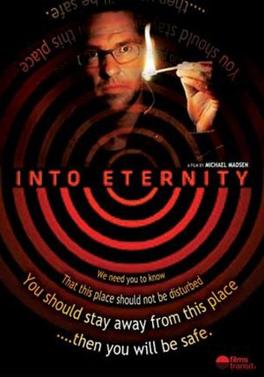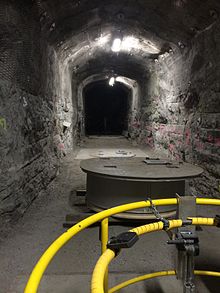
Radioactive waste is a type of hazardous waste that contains radioactive material. Radioactive waste is a result of many activities, including nuclear medicine, nuclear research, nuclear power generation, nuclear decommissioning, rare-earth mining, and nuclear weapons reprocessing. The storage and disposal of radioactive waste is regulated by government agencies in order to protect human health and the environment.

The Yucca Mountain Nuclear Waste Repository, as designated by the Nuclear Waste Policy Act amendments of 1987, is a proposed deep geological repository storage facility within Yucca Mountain for spent nuclear fuel and other high-level radioactive waste in the United States. The site is on federal land adjacent to the Nevada Test Site in Nye County, Nevada, about 80 mi (130 km) northwest of the Las Vegas Valley.

Dry cask storage is a method of storing high-level radioactive waste, such as spent nuclear fuel that has already been cooled in the spent fuel pool for at least one year and often as much as ten years. Casks are typically steel cylinders that are either welded or bolted closed. The fuel rods inside are surrounded by inert gas. Ideally, the steel cylinder provides leak-tight containment of the spent fuel. Each cylinder is surrounded by additional steel, concrete, or other material to provide radiation shielding to workers and members of the public.

Eurajoki is a municipality of Finland located in the region of Satakunta in the province of Western Finland. The municipality has a population of 9,143 and covers an area of 1,504.96 square kilometres (581.07 sq mi) of which 298.39 km2 (115.21 sq mi) is water. The population density is 17.75 inhabitants per square kilometre (46.0/sq mi).

KBS-3 is a technology for disposal of high-level radioactive waste developed in Sweden by Svensk Kärnbränslehantering AB (SKB) by appointment from Statens Strålskyddsinstitut. The technology was developed by studying different natural storage facilities such as the natural reactor in Oklo, Gabon and the uranium mine in Cigar Lake, Saskatchewan, Canada. The general theory is that radioactive rock in these sites has been present for thousands of years, and has not affected the health and well-being of human populations. KBS-3 is also to be used in Finland at the Onkalo spent nuclear fuel repository, being built by Posiva.

The Waste Isolation Pilot Plant, or WIPP, is the world's third deep geological repository licensed to store transuranic radioactive waste for 10,000 years. The storage rooms at the WIPP are 2,150 feet underground in a salt formation of the Delaware Basin. The waste is from the research and production of United States nuclear weapons only. The plant started operation in 1999, and the project is estimated to cost $19 billion in total.

The Olkiluoto Nuclear Power Plant is one of Finland's two nuclear power plants, the other being the two-unit Loviisa Nuclear Power Plant. The plant is owned and operated by Teollisuuden Voima (TVO), and is located on Olkiluoto Island, on the shore of the Gulf of Bothnia, in the municipality of Eurajoki in western Finland, about 20 kilometres (12 mi) from the town of Rauma and about 50 kilometres (31 mi) from the city of Pori.
Features, Events, and Processes (FEP) are terms used in the fields of radioactive waste management, carbon capture and storage, and hydraulic fracturing to define relevant scenarios for safety assessment studies. For a radioactive waste repository, features would include the characteristics of the site, such as the type of soil or geological formation the repository is to be built on or under. Events would include things that may or will occur in the future, like, e.g., glaciations, droughts, earthquakes, or formation of faults. Processes are things that are ongoing, such as the erosion or subsidence of the landform where the site is located on, or near.

The Nuclear Waste Policy Act of 1982 is a United States federal law which established a comprehensive national program for the safe, permanent disposal of highly radioactive wastes.

A deep geological repository is a way of storing hazardous or radioactive waste within a stable geologic environment. It entails a combination of waste form, waste package, engineered seals and geology that is suited to provide a high level of long-term isolation and containment without future maintenance. This will prevent any radioactive dangers. A number of mercury, cyanide and arsenic waste repositories are operating worldwide including Canada and Germany and a number of radioactive waste storage sites are under construction with the Onkalo in Finland being the most advanced.
As of 2023, Finland has five operating nuclear reactors in two power plants, all located on the shores of the Baltic Sea. Nuclear power provided about 34% of the country's electricity generation in 2020. The first research nuclear reactor in Finland was commissioned in 1962 and the first commercial reactor started operation in 1977. The fifth reactor started operation in April 2023.
Deep borehole disposal (DBD) is the concept of disposing high-level radioactive waste from nuclear reactors in extremely deep boreholes instead of in more traditional deep geological repositories that are excavated like mines. Deep borehole disposal seeks to place the waste as much as five kilometres (3 mi) beneath the surface of the Earth and relies primarily on the thickness of the natural geological barrier to safely isolate the waste from the biosphere for a very long period of time so that it should not pose a threat to humans and the environment. The concept was originally developed in the 1970s, but in 2014, a proposal for a first experimental borehole was proposed by a consortium headed by Sandia National Laboratories.

High-level radioactive waste management concerns how radioactive materials created during production of nuclear power and nuclear weapons are dealt with. Radioactive waste contains a mixture of short-lived and long-lived nuclides, as well as non-radioactive nuclides. There was reportedly some 47,000 tonnes of high-level nuclear waste stored in the United States in 2002.

Into Eternity is a 2010 Danish documentary film directed by Michael Madsen, released in 2010. It follows the construction of the Onkalo waste repository at the Olkiluoto Nuclear Power Plant on the island of Olkiluoto, Finland. Director Michael Madsen questions Onkalo's intended eternal existence, addressing an audience in the remote future.

The Schikorr reaction formally describes the conversion of the iron(II) hydroxide (Fe(OH)2) into iron(II,III) oxide (Fe3O4). This transformation reaction was first studied by Gerhard Schikorr. The global reaction follows:
Posiva Oy is a Finnish company with headquarters in the municipality of Eurajoki, Finland. It was founded in 1995 by Teollisuuden Voima and Fortum, two Finnish nuclear plant operators, for researching and creating a method of final disposal of spent nuclear fuel from their plants.

A Blue Ribbon Commission on America's Nuclear Future was appointed by President Obama to look into future options for existing and future nuclear waste, following the ending of work on the incomplete Yucca Mountain Repository. At present, there are 70 nuclear power plant sites where 65,000 tons of spent fuel is stored in the USA. Each year, more than 2,000 tons are added to this total. Nine states have "explicit moratoria on new nuclear power until a storage solution emerges". A deep geological repository seems to be the favored approach to storing nuclear waste.

FiR 1 was Finland's first nuclear reactor. It was a research reactor that was located in the Otaniemi campus area in the city of Espoo. The TRIGA Mark II reactor had a thermal power of 250 kilowatts. It started operation in 1962, and it was permanently shut down in 2015. At first, the reactor was operated by Helsinki University of Technology (TKK), and since 1971 by VTT Technical Research Centre of Finland.

Deep horizontal drillhole disposal is the concept of disposing of high-level radioactive waste from a nuclear reactor in deep horizontal boreholes instead of in more traditional deep geological repositories that are excavated like mines. The design concept is intended to improve upon the vertical borehole concept developed by Sandia National Laboratories, by utilizing modern advancements in directional drilling technology as well as using isotopic methods to measure the affinity a host rock has for isolation.
Vincent Ialenti is an American anthropologist who studies the culture of nuclear energy and weapons waste organizations. He is the author of Deep Time Reckoning, an anthropological exploration of how experts assessed the potential impact of Finland's Onkalo spent nuclear fuel repository on future ecosystems and civilization.
















